Unlock your genetic potential or gift the power of personalized health. Browse our Supersaver Packs now.
From glowing skin to better immunity, glutathione plays a significant role in your body. As a supplement, its popularity is skyrocketing due to its antioxidant properties. However, modifying your diet with supplements can be complex. Cutting back on a few lifestyle habits may be the right call to get the most out of your glutathione supplements. From your morning coffee to your glass of wine in the evening, here’s what to avoid when taking glutathione.
Did You Know?
Many aspects of your skin health and aging, including the risk for conditions like adult acne, rosacea, tanning, and the likelihood of premature wrinkles, stretch marks, cellulite, etc., are highly influenced by your genes. You can learn more about your skin using your existing ancestry genetic test DNA data.
Glutathione, the ‘king of antioxidants,’ is made up of three kinds of amino acids - glutamic acid, glycine, and cysteine.
Its primary job is to tackle the threat of free radicals.
Free radicals are harmful compounds that build up in your body over time.
Left unchecked, they could cause oxidative damage to your cells.
More often than not, these free radicals build up in the mitochondria.
Antioxidants like glutathione help protect your cells from these free radicals by scavenging them in the mitochondria.
Glutathione’s ability to protect the mitochondria helps fight off autoimmune diseases like lupus that target the mitochondria.
The role of glutathione in the body is as follows:
Due to these varied glutathione benefits, several dieticians, nutritionists, and physicians have only praises for it.
Annie Rubin, a registered dietitian, writes, “Glutathione is the body’s most potent antioxidant molecule and is also known as the Master Antioxidant.”
While the body usually produces adequate glutathione, stress, poor diet, or a chronic health condition can reduce glutathione levels.
Some people may be born with a change in the GSS gene responsible for producing glutathione synthetase, the enzyme that produces glutathione.
GSS gene mutations can severely decrease glutathione levels, leading to a deficiency disease. The symptoms of glutathione deficiency look like:
Doctors may suggest supplementation if you are low on glutathione.
Along with chemotherapy drugs, it can promote cell repair and flush out toxic substances.
Some studies suggest that higher glutathione can help manage body weight and fat percentage.
Interestingly, some people choose glutathione for its supposed ability to lighten skin tone.
However, it isn’t effective.
Any noticeable change is reversed soon after stopping glutathione.
Glutathione is commonly available as:
Glutathione supplements come in a variety of forms such as capsules, gels, liquid supplements, skin patches, sprays, and IV injections.
The NIH recommends taking 500-1000mg of glutathione daily (oral or liposomal) alongside other nutrient-rich foods to promote healthy glutathione levels in your body.
Remember to speak to your doctor or a licensed nutritionist about the right frequency and dosage of glutathione beforehand.
To prevent unpleasant side effects or lowered efficiency, here are a few things to avoid when taking glutathione supplements.
Smoking is a preventable cause of oxidative damage in the body.
People who smoke regularly have increased levels of cadmium and malondialdehyde in their blood, which can lead to further cell toxicity.
Since glutathione primarily fights off oxidative stress and toxic pollutants, smoking may cancel out the beneficial effects of glutathione.
Excess alcohol consumption can damage the liver, which helps metabolize glutathione.
Like smoking, alcohol consumption also leads to oxidative damage by activating cytochromes and other reactive oxygen species.
The liver metabolizes alcohol to aldehydes, which cause hangovers.
While glutathione can help detoxify the body from aldehydes, this task impairs its overall efficiency in other parts of the body.
Glutathione may not be beneficial to the body if combined with alcohol consumption.
While there are no specific drug interactions identified for glutathione, this does not mean there aren’t any.
Some experts say that analgesics like aspirin and acetaminophen can strain the liver when metabolized.
This task could deplete the body’s glutathione reserves.
If you are on medications, please talk to your doctor before starting glutathione.
Some studies have shown that moderate caffeine consumption reduces oxidative stress in the body.
However, caffeine consumption may reduce glutathione levels in the body.
Consuming caffeine and glutathione together may affect glutathione absorption levels and reduce its bioavailability.
So, to optimize glutathione supplementation, avoid coffee a few hours before or after taking the supplements.
Balancing out moderate coffee consumption with a diet that promotes glutathione levels is the best option.
Aspartame is a popular zero-calorie sweetener used in many foods and beverages to reduce overall sugar and calorie count.
However, if consumed regularly, it can lead to inflammation in the liver.
This inflammation due to long-term aspartame consumption may decrease reduced and oxidized glutathione levels in the liver.
Aspartame’s oxidative stress can take a toll on the adrenal gland as well.
Avoiding aspartame when taking glutathione may improve the effectiveness of the antioxidant.
There are two reasons why preservative-laden food and beverages may not benefit those on glutathione supplementation.

While regular doses of glutathione are generally well tolerated, high doses may be toxic to the body.
In rare cases, too much glutathione can cause diarrhea, nausea, vomiting, headaches, or skin rashes.
If you experience any new symptoms while on glutathione, stop taking it and speak to your primary care provider.
Individuals with existing health conditions must consult a doctor before using glutathione supplements.
The effects of glutathione on pregnant or breastfeeding women haven’t been studied well.
Avoiding the supplement during these phases is better unless a doctor recommends it.
People with severe liver or kidney conditions must exercise caution while using any supplement.
Some studies report that vitamin E and C levels help raise serum glutathione levels and make it more effective for the body.
Eating foods rich in vitamin E and vitamin C is one way to improve glutathione absorption.
Selenium, an essential mineral, is needed for the body to absorb and use glutathione.
Studies report that selenium supplements increased serum glutathione levels in just three months.
Foods like organ meat, beef, fish, cottage cheese, and brown rice are natural sources of selenium.
It may not be accurate to say that taking glutathione can affect the menstrual cycle.
However, some studies report that taking glutathione while on your period may increase serum estrogen levels during menstrual cycles.
Estrogen is a beneficial hormone during the fertile periods of the menstrual cycle and plays a role in preparing the body for pregnancy.
Vitamin D keeps your skeletal and immune systems healthy. You usually get it from the sun, so it could be challenging to maintain healthy vitamin D levels sometimes.
A study found that vitamin D supplementation with glutathione might be beneficial since it increases glutathione peroxidase-1 levels.
Consult a doctor or nutritionist before modifying, starting, or stopping a supplement regimen.
The following are some of the natural sources of glutathione.
A 2007 study reports that almond consumption increases serum glutathione levels by up to 16% and reduces DNA damage by up to 29%.
Almonds also have various other health benefits and are beneficial when eaten regularly.
Turmeric is a yellowish spice used to add color and taste to food.
Curcumin, a chemical present in turmeric, is an excellent antioxidant.
Studies report that curcumin increases glutathione S-transferase (GST) activity in the liver.
According to a 2017 study, avocado oil may help increase glutathione levels produced in the liver and offer enhanced antioxidant properties.
Consuming foods rich in sulfur amino acids may help improve glutathione synthesis, according to a 2011 study.
Some foods rich in sulfur amino acids are cruciferous vegetables, turkey, beef, chicken, nuts, legumes, allium vegetables like garlic, onions, leeks, and shallots, and leafy greens.
Milk thistle is a natural herb used for its medicinal properties.
It contains a compound called silymarin, which may help restore glutathione levels in the body and modulate the activities of the enzymes that metabolize glutathione.
Here are some other tips to help get the maximum effects of glutathione.

Should You Take DGL Supplements For Treating Acid Reflux?

Supplements To Increase Brown Fat

Top 7 “Natural” Supplements Associated With Liver Damage
https://www.ncbi.nlm.nih.gov/pmc/articles/PMC3635210/
https://pubmed.ncbi.nlm.nih.gov/30116319/
https://pubmed.ncbi.nlm.nih.gov/32373172/
https://www.ncbi.nlm.nih.gov/pmc/articles/PMC5808366/
https://pubmed.ncbi.nlm.nih.gov/28187322/
https://pubmed.ncbi.nlm.nih.gov/21693129/
https://pubmed.ncbi.nlm.nih.gov/12622769/
https://www.ncbi.nlm.nih.gov/pmc/articles/PMC5413479/
https://www.thaiscience.info/Journals/Article/CMMJ/10905033.pdf
https://www.researchednutritionals.com/why-do-we-need-liposomal-glutathione/
https://www.cdc.gov/nchs/data/nhsr/nhsr183.pdf
https://www.ncbi.nlm.nih.gov/pmc/articles/PMC4090673/
https://pubmed.ncbi.nlm.nih.gov/8317379/
https://www.ncbi.nlm.nih.gov/pmc/articles/PMC4360843/
https://www.ncbi.nlm.nih.gov/pmc/articles/PMC7070325/
https://pubmed.ncbi.nlm.nih.gov/18029489/
https://pubmed.ncbi.nlm.nih.gov/9675878/
https://pubmed.ncbi.nlm.nih.gov/20471805/
https://pubmed.ncbi.nlm.nih.gov/20600218/
https://www.webmd.com/vitamins-and-supplements/glutathione-uses-risks
https://www.ncbi.nlm.nih.gov/pmc/articles/PMC7196133/
https://www.ncbi.nlm.nih.gov/pmc/articles/PMC4684116/
https://www.healthline.com/nutrition/how-to-increase-glutathione
https://www.news-medical.net/news/20240929
https://pubmed.ncbi.nlm.nih.gov/23421037
Cloves are the dried flower buds of the tropical evergreen plant Syzygium aromaticum. They have an intense, slightly sweet flavor and are used as a spice, particularly in Indian cuisine. However, traditional medicine has also used cloves to cure indigestion, relieve pain, and fight infections. A recent trend claims that the benefits of clove water are the same, if not more. Just how true is this claim?
One tablespoon of cloves has:
| Nutrient | Content |
| Calories | 6 |
| Sodium | 13 milligrams (mg) |
| Calcium | 13 mg |
| Potassium | 21 mg |
| Magnesium | 5.4 mg |
| Manganese | 1.2 mg |
| Carbohydrates | 1.4 grams |
| Vitamin K | 3 micrograms (µg) |
Clove water is made by boiling whole cloves in water.
Some people claim that consuming it regularly will improve sleep and help you lose weight.
However, more evidence is needed to support these claims.
Clove water is best consumed first thing in the morning.
You can prepare it either the night before or on the spot.
Here’s how to make a healthy cup of clove water:
For best results, boil the cloves in water for 5-10 minutes.
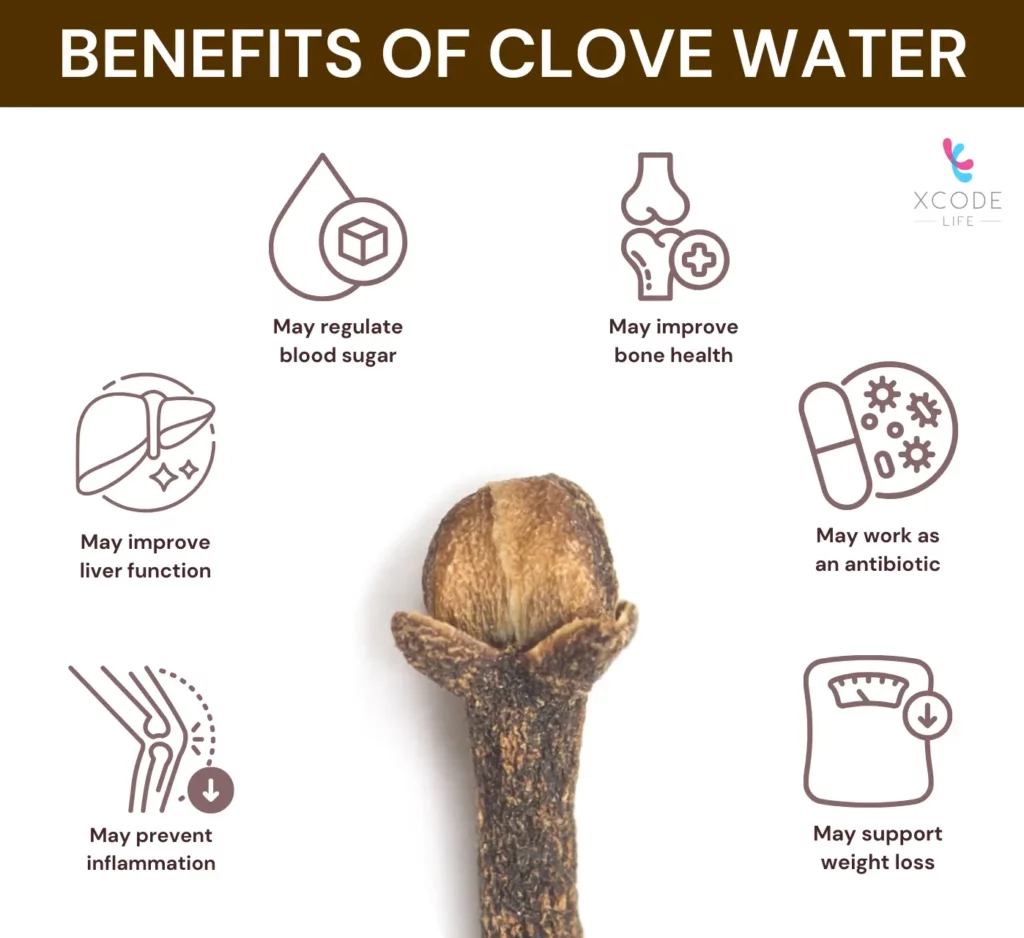
Cloves can aid digestion, speeding up your metabolism.
They also help control blood glucose levels, reducing the amount of subcutaneous fat your body stores.
One study on animals also showed that cloves can also inhibit fatty acid synthesis.
Thanks to these properties, clove water can help support weight loss.
Studies have shown that cloves can help fight stomach ulcers.
Stomach ulcers happen due to the thinning of your stomach’s protective mucus layer that keeps stomach acid at bay.
Consuming healthy amounts of cloves could prevent this thinning and help fight stomach ulcers.
Cloves can also safeguard your liver against diseases.
Some studies show that cloves can protect you against liver cirrhosis and fatty liver disease.
However, more research is required to support this claim entirely.
A study on non-human subjects showed that cloves can help lower blood sugar levels.
However, taking clove supplements along with insulin can be dangerous.
It can severely lower blood glucose levels, resulting in a life-threatening hypoglycemic state.
While it is beneficial to an extent, clove water should never be used as an alternative to prescription diabetes medications.
Some studies have shown cloves’ antibiotic-like properties.
This means they can help fight off infections caused by microbes like bacteria.
For the same reason, cloves are often used in naturopathic mouthwashes.
Clove-based mouthwashes may also help prevent cavities and other oral health problems.
Low bone mass is a condition where your bones don’t have enough calcium.
Over time, this can lead to osteoporosis and frequent falls and fractures.
Some preliminary studies show that consuming cloves can increase bone mass.
Cloves also contain manganese, which is essential for bone formation and health.
However, more research is needed to understand how cloves can help promote bone health.
Inflammation is the body's natural response to a bacterial infection or other harmful stimuli.
If uncontrolled, it can cause pain and discomfort and lead to several pathological conditions.
Cloves contain an anti-inflammatory compound called eugenol.
Thus, consuming cloves can lower your body's inflammatory response.
The risk of inflammatory diseases like arthritis and the extent of their symptoms can also be reduced.
Cloves could temporarily relieve toothaches because of their anti-inflammatory and antiseptic properties.
Cloves may have multiple benefits for men, significantly improving sexual health.
All the studies mentioned here used whole cloves or clove oil.
More research is needed to ascertain if clove water has the same benefits on the body.
Children, pregnant and nursing women should avoid clove water, those who have undergone surgery, and people suffering from diabetes or blood clotting issues.
If consumed improperly, cloves can have some side effects, including:
Always consult your doctor before starting to take clove water.
There aren't many reliable studies showing how much clove is safe for you.
When you consume clove water every day, you don't know how much eugenol you are consuming daily.
Too much eugenol can cause decreased blood clotting, vomiting, and diarrhea.
It is best to consult a doctor or nutritionist about how much cloves will be safe for you.
This is especially important if you suffer from liver disease, clotting disorders, or a weak immune system.
You can safely consume 2-6 whole cloves daily for maximum health benefits.
However, it is best to consult a healthcare provider to know exactly how much clove you can safely consume, given your health conditions.
While some claim that drinking clove water before bed can aid digestion and prevent stomach upsets, no concrete research currently supports this.
Conversely, there is little evidence against having clove water just before bed.
Clove has antifungal and antibacterial properties and may help fight infections.
Experts may sometimes recommend clove oil as a temporary pain relief for toothache.
You can use clove water as a natural mouthwash.
Add honey, lemon, or ginger to clove water for added benefits.
This is a popular Ayurvedic concoction that can treat colds and coughs.
Boil a few whole cloves with some ginger.
Add a dash of lemon and drizzle some honey before consuming it.
You can refrigerate clove water and store it for a week.
However, fresh clove water always offers more health benefits.

12 Simple Ayurvedic Practices To Improve Your Overall Wellbeing

The Ultimate Guide To Anti-inflammatory Diet + Food List PDF

How It Works: Genetic Testing For Weight Loss
https://pubmed.ncbi.nlm.nih.gov/28726934
https://www.wellandgood.com/benefits-of-cloves/
https://pubmed.ncbi.nlm.nih.gov/32352181
https://pmc.ncbi.nlm.nih.gov/articles/PMC6217746
https://pmc.ncbi.nlm.nih.gov/articles/PMC10383178/
Brown fat, or brown adipose tissue, is a type of body fat that regulates body temperature in cold conditions.
It’s activated when the cold makes you shiver.
Brown fat keeps you warm by storing energy and burning calories.
Since brown fat keeps the body warm, it is abundant in babies and hibernating mammals.
Adults have lesser brown fat, usually found near the neck, shoulder blades, and kidneys.
Since brown fat is known to burn more calories, researchers are studying its role in fighting obesity.
The body has a smaller percentage of brown fat than white fat.
According to studies, brown fat has more mitochondria than white fat, meaning it’s more metabolically active.
The body has three different types of fat:
Here’s the difference between white and brown fat:
| White Fat | Brown Fat |
| Stores energy in larger fat droplets | Has smaller fat droplets |
| Fewer mitochondria | Plenty of mitochondria |
| Mitochondria contain less iron | Mitochondria are rich in iron, imparting a brownish color |
Brown fat has several health benefits beyond just regulating body temperature.
Activated brown fat can absorb branched-chain amino acids.
These are compounds found in the bodies of people with obesity and type II diabetes.
Preliminary studies have studied this claim and suggest that brown fat may have some connection to weight loss.
A recent study has found a correlation between brown fat and metabolic conditions like diabetes.
Since brown fat burns glucose for fuel, it can affect blood sugar levels.
Thus, a high level of brown fat activation could signal the early stages of diabetes.
More research is needed to confirm this link.
Studies have investigated the link between brown fat and heart disease.
In one study, people underwent PET scans to study their heart health.
Interestingly, those with more brown fat cells were at a lower risk for:
Cancerous cells rely on the energy from glucose breakdown to grow and spread.
A recent study exposed tumor-bearing mice to cold conditions to study its effect on cancer.
They found that tumor growth slowed considerably since brown fat activation used up much of the available glucose.
While this is still an early study, further research into the anti-tumor properties of brown fat is ongoing.
Yes, you can convert white fat to brown fat by:
Supplements usually contain a host of nutrients and antioxidants that nourish the body and help meet certain nutritional requirements.
When seeking supplements to increase brown fat, look out for the following nutrients and antioxidants:
Brown fat has several health benefits.
It helps regulate body temperature while also stimulating better metabolism.
Supplements to increase brown fat contain beneficial compounds like capsaicin, poly-unsaturated fatty acids, omega-3 fatty acids, and others.
Several studies have validated their role in activating brown fat cells, which has led to marked health benefits.
However, modifying your diet to include supplements can be complicated, depending on your nutritional status and existing health conditions.
It’s best to consult a licensed nutritionist or doctor before beginning any supplement regimen.
They can guide you toward an optimal dosage and frequency of supplements to increase brown fat.
Apart from supplements, if you’re wondering how to increase brown fat cells, you could try:
You can get brown fat from the foods you eat.
A few foods that help increase brown fat are:
Combining good fats with vegetables, whole grains, lean proteins, and dairy creates a well-balanced diet to increase brown fat.
Adding iron to your diet through meats and seafood, leafy greens, and beans helps increase the brown fat in your body.
Brown fat is activated just before you start shivering. So, taking a cold shower, an ice bath, or turning down the thermostat can activate brown fat and stimulate your body to produce more heat.
Getting your daily dose of physical exercise is good for your health in many ways.
Studies have noted that exercise activates irisin, a hormone in the blood that instructs the white fat in your body to burn like brown fat. This process creates beige fat.
Getting a good night’s sleep increases the amount of melatonin your body produces. This helps activate brown fat, keeping diseases like diabetes at bay.
Maintaining a cooler room temperature while sleeping can also help burn brown fat passively.
PET scans, CT scans, MRI scans, thermal imaging, and blood panels all help measure the amount of brown fat in your body.
Yes, coffee stimulates brown fat cells, improving your metabolism and stimulating proper thermal regulation. The catechins in green tea also have a similar effect.
Scientists have observed the effect of intermittent fasting on mice and noted that it leads to the browning of white fat, a beneficial outcome. While scientists have yet to replicate this study in humans, it is promising.

Should You Take DGL Supplements For Treating Acid Reflux?

Top 7 “Natural” Supplements Associated With Liver Damage

How It Works: Genetic Testing For Weight Loss
Finding a balance between health and weight management can be challenging if you have hypothyroidism. While intermittent fasting has revolutionized the health and wellness sphere with its benefits for weight loss and health regulation, it’s essential to learn about its application to people struggling with hypothyroidism. This article is a deep dive into its benefits and potential risks, exploring the association between intermittent fasting and hypothyroidism.
The thyroid gland is a butterfly-shaped organ in the front of the neck.
It secretes the T3 and T4 hormones necessary for normal metabolism and functioning.
The pituitary gland in your brain regulates the thyroid through the thyroid-stimulating hormone (TSH).
Hypothyroidism is a disease affecting your thyroid that can occur due to:
Hypothyroidism slows down your body’s metabolism considerably.
This can lead to symptoms like:
For more information, the American Thyroid Association offers helpful brochures on all aspects of hypothyroidism.
Did You Know?
Genetic ancestry tests are becoming increasingly popular. While your DNA can be used to learn about your roots, it can also reveal important things about your health risks and wellness aspects. This allows you to take proactive measures for health conditions, even before the symptoms appear, thereby preventing it. You can upload your DNA data to learn 1,500+ things about your health. Learn more.
Intermittent fasting, or time-restricted feeding, is a specific time-bound eating pattern.
Unlike diets where certain foods are eliminated or restricted from consumption, intermittent fasting emphasizes the time between meals.
Intermittent fasting can help delay aging, improve metabolism, and lose weight.
There are different ways to do intermittent fasting.
Some of the most popular fasting schedules include:
Julia Zumpano, a registered dietician, advocates for intermittent fasting.
She says, “We see a lot of benefits from a fasting state, even if it's a slight form of fasting, because what happens is that our body shifts its form of metabolism.”
Some of these benefits include:
Researchers have verified the benefits of intermittent fasting and recommend it for treating obesity and insulin resistance if done right.
Eating without fasting can elevate your blood sugar levels, causing inflammation.
Inflammation increases insulin resistance, increasing your risk of diseases like cancer.
Although intermittent fasting has many benefits, it may not be for everyone.
Consult a medical professional to determine if it’s right for you and what fasting technique could work best for you.
The thyroid gland is essential for metabolism.
It secretes hormones essential for the body’s normal functioning.
Thus, any fasting affects this organ directly.
Dr. David Jockers, who specializes in naturopathic medicine, strongly recommends intermittent fasting for hypothyroidism. “A fasting lifestyle is a healthy lifestyle,” he says.
Some people may benefit from intermittent fasting, but others may not have the same experience.
Intermittent fasting could do more harm than good for people with diabetes.
While it can improve insulin resistance, it can also cause blood sugar to drop drastically.
Some diabetes medications are affected by eating patterns, so it’s best to consult a doctor before beginning intermittent fasting.
The benefits of intermittent fasting for hypothyroidism include reduced inflammation and weight loss.
However, when not done correctly, skipping meals or fasting for multiple days may lead to nutrient deficiencies that may worsen hypothyroidism.
Research generally reports intermittent fasting can help alleviate hypothyroidism symptoms by decreasing body weight and improving insulin resistance without affecting thyroid hormones.
Thus, it’s important to understand exactly when and when not to do intermittent fasting in case you have hypothyroidism.
Dr. Eric Berg, DC, says, “Intermittent fasting… helps your body convert T4 to T3, just as selenium does. Because T3 is the active form of thyroid hormone, having more of it will improve your thyroid function if you’re hypothyroid.”
However, some studies report intermittent fasting affects thyroid function by lowering T3 and T4 hormone levels.
This can worsen hypothyroidism.
Intermittent fasting can help you manage hypothyroidism and Hashimoto’s disease.
But you must be sure that your adrenal glands are functioning decently and that you don’t have diabetes.
However, intermittent fasting may be beneficial for hypothyroidism if done correctly.
Intermittent fasting affects people differently.
If you have any health issues, including hypothyroidism, consult a doctor for an optimal diet plan.
Food is one of many factors responsible for properly absorbing thyroid medications.
If you are on medications for thyroid health, such as Synthroid, levothyroxine, or armor, fasting can help you absorb them better.
Taking these medicines first thing in the morning on an empty stomach is advisable for better results.
It’s essential to remember that this is an informational article that shouldn’t be considered a substitute for professional medical advice.
If you are on medication, talk to your doctor before changing the timings, dosage, or diet.
While intermittent fasting involves avoiding eating for long periods, calorie restriction means reducing your daily calorie intake without necessarily cutting out meals. Both techniques are reasonably effective for weight loss.
Over time, regular exercise and a healthy diet can stabilize poor thyroid metabolism. Some medications like levothyroxine may also help.
Overnight fasting (12-14 hours) is enough for people with hypothyroidism to start seeing some benefits. It allows sufficient fat breakdown and reduces the chances of adverse side effects from starvation.
Eggs are a healthy option for people with hypothyroidism. They contain selenium, iodine, and vitamin D, which are beneficial for thyroid function.
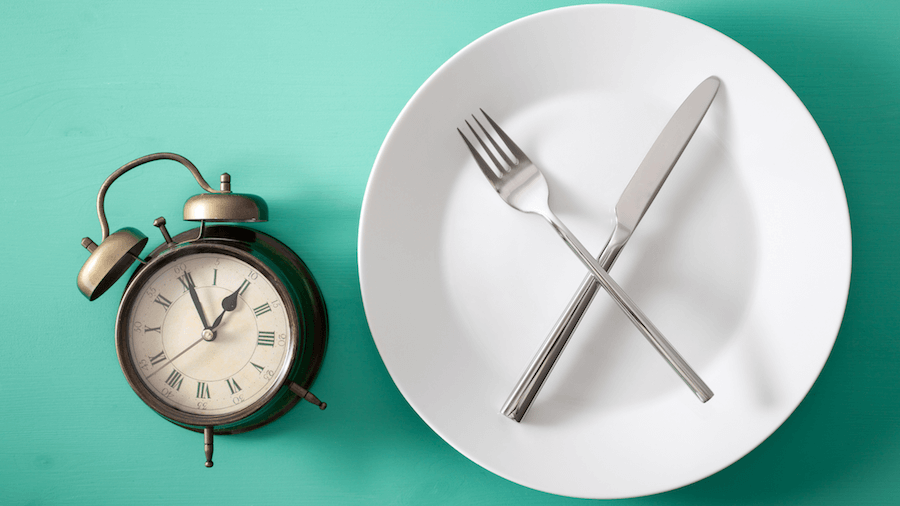
Intermittent Fasting & Weight Loss: Eating Less Or Eating Less Frequently?

Is Hypothyroidism Genetic?

A Complete Guide To Fasting Teas: The Dos, Donts, Benefits, & Risks
Muscle movement, nerve signaling, bone health, electrolyte balance, heart rhythm, and other crucial body functions are affected when you’re low on potassium. Low potassium, or hypokalemia, is a state of dangerously low potassium levels in your blood. Rarely occurring due to a poor diet, hypokalemia often occurs with an underlying disease. Studies have investigated whether low potassium is a sign of cancer. Read on to learn which cancers it may be associated with and how to manage it.

The normal range is between 3.6 and 5.2 millimoles per liter(mmol/L), but people with severe hypokalemia have under 2.5 mmol/L of potassium in their blood.
Hypokalemia can lead to symptoms like:

Low potassium levels aren’t a direct indicator of cancer.
However, several kinds of cancer exhibit hypokalemia as a side effect.
Colon cancer can lead to excessive diarrhea, which causes potassium loss over time.
If a tumor forms on or near the colon, potassium absorption from food in the intestines may be impaired.
These conditions can reduce the amount of potassium in your blood, leading to hypokalemia.
McKittrick-Wheelock syndrome is a rare complication of colon cancer that causes severe depletion of electrolytes like potassium.
One of the most common causes of low potassium levels is mineral loss through urine.
Usually, kidneys filter out potassium from urine, allowing the body to re-absorb it.
Renal cancer often leads to hypomagnesemia, a state of low magnesium in the body.
Since magnesium helps transport and absorb potassium, low magnesium levels can equal low potassium.
Aldosterone is a hormone secreted by the adrenal glands that regulates the amount of potassium in your blood.
Primary hyper-aldosteronism is a disease where excess aldosterone is secreted, drastically lowering blood potassium levels.
Some adrenal cancers can cause primary hyperaldosteronism, leading to dangerously low potassium levels.
Chemotherapy with drugs like cisplatin, cetuximab, eribulin, and ifosfamide can lower potassium levels as a side effect.
They may induce vomiting or diarrhea, further affecting potassium levels.
Anticancer pills or liquids reduce magnesium levels, leading to lowered potassium.
Medications that affect the kidney can prevent proper reabsorption of potassium.
Drugs that cause intestinal inflammation can affect potassium absorption.
Low potassium can have genetic links.
Some rare genetic kidney conditions can lead to excessive potassium excretion.
Bartter’s and Gitelman’s syndromes prevent your kidneys from reabsorbing salts.
They are then excreted through the kidney, causing excessive electrolyte losses and hypokalemia or low potassium.
The genes responsible for these diseases are:
| Disease | Causal Gene |
| Bartter’s Syndrome Type I | SLC12A1 |
| Bartter’s Syndrome Type II | KCNJ1 |
| Bartter’s Syndrome Type III | CLCNKB |
| Bartter’s Syndrome Type IV | BSND or CLCNKA & CLCNKB |
| Gitelman’s Syndrome | SLC12A3 and TRPM6 or CLCNKB (rare) |
Both conditions are inherited in an autosomal recessive manner.
You can only develop the condition if both parents carry at least 1 copy of the mutated gene(s).
Hypokalemia or low potassium has a link to kidney failure.
Kidneys can usually filter out potassium and maintain your blood electrolyte levels.
When your kidneys fail, your potassium level drops.
Potassium helps regulate several bodily processes across multiple organ systems.
Low potassium reduces the efficiency of nerve signal transduction, impairing muscle movement.
Impaired muscle movement leads to further complications as hypokalemia worsens.
Generally, water consumption has almost no effect on potassium levels.
Theoretically, drinking water can lower potassium levels, but it’s not a safe bet.
The risk of affecting other electrolyte levels is also high, so modifying your diet is best.
Low potassium or hypokalemia can cause thirst, body weakness, and dizziness. In some cases, it can also cause paralysis and heart rhythm disturbances.
While low potassium levels typically do not indicate cancer, some types of cancer, like renal, adrenal, and colorectal cancer, can result in hypokalemia.
If you have concerns regarding low potassium levels or your cancer risk, please consult your doctor.
To maintain healthy potassium levels, eat a potassium-rich diet and consider potassium supplements. In severe cases, you could require hospitalization and be fed potassium through an IV tube.

Do Tattoos Cause Cancer Like Lymphoma?

The Link Between Vitamin D And Raynaud's Disease

Is Prostate Cancer Hereditary?
https://www.tandfonline.com/doi/full/10.1080/20009666.2018.1514943
https://www.mayoclinic.org/symptoms/low-potassium/basics/definition/SYM-20050632?p=1
https://www.mayoclinic.org/symptoms/low-potassium/basics/causes/sym-20050632
https://www.webmd.com/digestive-disorders/hypokalemia
https://my.clevelandclinic.org/health/diseases/17740-low-potassium-levels-in-your-blood-hypokalemia
https://www.medicalnewstoday.com/articles/321735
https://pubmed.ncbi.nlm.nih.gov/35604734
https://medlineplus.gov/ency/article/000479.htm
https://medlineplus.gov/genetics/condition/gitelman-syndrome
https://medlineplus.gov/genetics/condition/bartter-syndrome
https://www.ncbi.nlm.nih.gov/pmc/articles/PMC6204505
https://www.ncbi.nlm.nih.gov/pmc/articles/PMC6521821
https://www.ncbi.nlm.nih.gov/books/NBK482465
https://www.ncbi.nlm.nih.gov/books/NBK459304
Testing to learn about your ancestry can tell you more than you think. Genetic testing is the most scientific and popular type of DNA ancestry test today. Alternative techniques that claim to estimate your ancestry have existed for years now. One of these techniques is foot shape ancestry determination. It may not seem accurate at first glance, but there’s a lot to be learned about your ancestors through simply observing your feet. This article will get to the bottom of foot shape ancestry, telling you everything you need to know about this offbeat technique.
Foot shape ancestry is essentially what the shape of your feet reveals about you and your ancestors.
It studies parameters like arch shape and toe patterns to estimate your ethnicity.
Human feet vary in appearance greatly among individuals.
Sometimes, the left and right feet look dissimilar even in the same person.
Based on shape, the five different foot shapes used in foot shape ancestry are–
These shapes are distinguished by their outline and the length of the digits.
You usually inherit most foot shape traits autosomally (from non-sex chromosomes).
Each parent passes down one copy of a gene, and the dominant trait is expressed accordingly.
However, some traits may be X-linked (from the X chromosome).
This creates a disparity in inheritance between males and females.
Since males have only one X chromosome and the Y chromosome is inert, one copy of an X-linked gene equals an expressed trait.
On the other hand, females have two X chromosomes.
Like on any other chromosome, they would need to inherit two copies of an X-linked trait for it to be expressed.
Let's take a deeper look at what ancestry different foot shapes could indicate.
People with a long second digit on their feet are said to have Greek feet or ‘flame feet.’
A study showed that this trait is common in the Greek population.
You can also observe this feature in several Greek statues.
Greek feet have an uneven weight distribution due to their longer second toe, which can cause frequent aches.
However, this foot shape is advantageous for professional athletes.
Research into toe length genetics has shown that the Greek foot is an X-linked recessive trait.
Essentially, this trait is present on the X chromosome and inherited only if both parents have a Greek foot.
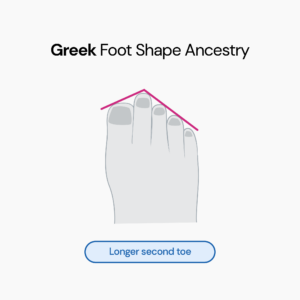
A Roman foot shape is characterized by having the first three toes of equal length while the others are shorter.
About 1/4th of the world’s population likely has Roman feet.
People with this foot shape often find it difficult to wear specific footwear like stilettos.
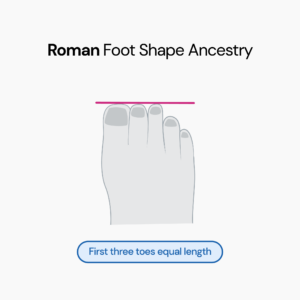
A Germanic foot shape is characterized by a large first digit and the other four toes of roughly the same size.
The toes in this foot shape are also wider and stockier than in other foot types.
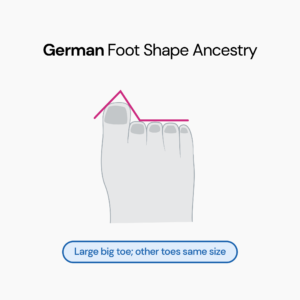
The Celtic foot shape is a combination of Germanic and Greek toes.
Like a Greek foot, it has a taller second toe.
Like a Germanic foot, its other toes are of a similar size.
From the third toe, the size progressively reduces.
For this reason, this toe shape is considered complex and variable.
The Celtic foot shape is common in Western Europe, especially Britain and Ireland.

Egyptian foot shape is said to be the neatest of the five shapes.
It is characterized by a long big toe, followed by other toes reducing in size at a 45-degree angle.
This foot shape has a medical advantage as it protects against ingrown toenails.
Interestingly, 80% of people in Japan have an Egyptian foot shape, which is why Japanese footwear is often designed with these feet in mind.
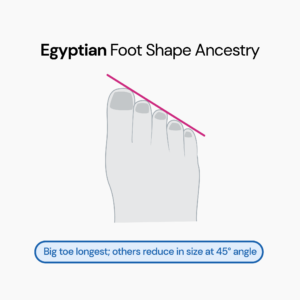
There isn’t a single perfect system or chart that helps determine your foot shape.
The outline of your feet and toe sizes can help determine your foot shape.
Regarding the images and descriptions in this article, you can take a photo of your foot or draw its outline on a paper to compare it.
There is no scientific link between foot shape and ancestry.
While foot shape ancestry is very descriptive and offers some information about genetic traits, science does not support the idea.
It’s a common misconception that foot shape can be used to determine your ancestry, but this is wholly wrong.
Foot shape ancestry is not accepted as a standard scientific practice to determine lineage because it is based on an entirely wrong premise.
As per foot shape ancestry, each population comprised one group of people (monolithic populations), all with the same traits.
However, in reality, populations have migrated, mixed, and mingled over generations.
This means there was never a monolithic population with one type of foot.
At the same time, we cannot presume that people with one kind of foot shape originated in the same place.
For example, northern Japan's secluded Indigenous Ainu people happen to have Greek foot shape features.
Wouldn’t it be bizarre to claim they originated in Greece?
In "The Archaeology of Human Bones," Dr. Simon Mays says that while certain skeletal traits can help reconstruct our evolutionary journey, environmental influences and individual variation often complicate these tasks. Therefore, foot morphology alone cannot be a reliable indicator of ancestry.
The entire premise of foot shape ancestry is based on the assumption of a monolithic population, so it cannot be considered accurate.
While it is fun to know more about what your feet reveal, there are scientific ways to determine your ancestry and lineage, such as DNA tests.
While foot shape ancestry assigns specific foot shapes to an ethnic group, foot shape can vary widely within a single group.
Evolutionary agents and genetics determine foot shape, leading to variations within and across populations.
Multiple traits, such as toe length, arch height, and foot width, determine your overall foot shape.
Since several genes are at play, you inherit some of these genes from each parent.
Viking toe means your second toe is longer than your big toe.
Other turkey toe names include Morton's, Greek, and royal toe.

7 Physical Signs Of Viking Ancestry That May Suggest You Have Viking DNA

Jewish DNA Test: Can Genetic Tests Help Identify Jewish Ancestry?

How It Works: Are Freckles Genetic?